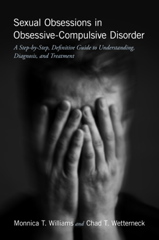Expert Help for OCD
Take Your Life Back from OCD
Offering expert treatment for all types of OCD, including unwanted obsessional thoughts. Our OCD treatment program is typically 10 weeks. We offer twice-weekly sessions, groups, and intensive programs. Intensive program can be in person or online. Low cost options available. Contact us...
Behavioral Wellness Clinic
392 Merrow Rd, Suite E,
Tolland, CT 06084
Office: (860) 830-7838
OCDTYPES
Obsessive-compulsive disorder comes in many forms
Sexual Worries in OCD
Dr. Monnica T. Williams, Board Certified, Licensed Clinical Psychologist
OCD Expert Researcher and Clinical Supervisor
OCD Overview
Obsessive-compulsive disorder (OCD) is considered a type of anxiety disorder that involves recurring, unwanted obsessions and repetitive compulsions. Obsessions are intrusive thoughts that cause severe distress, despite the fact that the individual realizes that the obsessions represent exaggerated fears that are not likely to occur. These obsessions are worries that reach beyond anxiety about everyday problems. So upsetting are the obsessions, that the individual attempts to counteract them with a specific behavior or neutralizing thought called a compulsion or ritual. The individual feels as though their compulsions must be performed in response to the obsessions. Compulsions are implemented to reduce anxiety or prevent a feared outcome.
What is sexual OCD?

Sexual OCD: A Misunderstood OCD Subtype
Obsessions and compulsions can take many different forms, depending on the individual and their type of OCD. Several studies have attempted to classify the various symptom profiles into discrete subtypes of OCD, also called symptom dimensions. The research literature generally agrees that there are about four major OCD dimensions: contamination, doubt/harm, symmetry/arranging, and unacceptable/taboo thoughts. The unacceptable/taboo thoughts type has also been called "obsessions without covert compulsions" (sometimes called "pure obsessions" or "pure o" for short). Within this category are sexual obsessions, which are unwanted sexual thoughts, often involving children, family members, animals, violence, or even religious figures. These sexual obsessions may involve same-sex activities or fears about changing sexual orientation. While much research has been conducted on certain OCD subtypes, less research has been conducted examining sexual obsessions.
Sexually Intrusive Thoughts
Sexually intrusive thoughts are extremely common, and among the general population, over ninety percent of individuals report having experienced these type of thoughts during their lifetime. Studies have found that as many as a quarter of OCD patients have had a history of sexual obsessions. These numbers may be an underestimate of the actual number of people suffering from unwanted sexual obsessions because the stigma associated with sexual thoughts may cause individuals to avoid reporting their obsessions. Sexual obsessions and sexually intrusive thoughts are equally divided among males and females. These thoughts typically start in early adolescence and may progressively worsen, or have a waxing and waning course.
When conceptualizing sexual obsessions, it is important to recognize that people with sexual obsessions find their thoughts immoral and do not wish to act them out. They are different from fantasies, as the obsessions are unpleasant and provoke guilt, rather than being enjoyable. As a result, the thoughts cause distress, which may be connected to unwanted emotions, such as lust, disgust, anger, and frequently guilt. This distress is directly related to the frequency of the sexual obsessions, and may lead to depression, difficulties concentrating, and anxiety. Sometimes fixating on the thoughts can even lead to a groinal response.
Treatment for Sexually-Themed OCD
Sexual obsessions in OCD are frequently misdiagnosed, even by licensed psychologists. Thus it is vitally important that people with sexual obsessions in OCD be treated by an experienced and effective OCD therapist.
Learn more from Dr. Monnica Williams, who explains sexual worries, fears, and anxieties in obsessive-compulsive disorder in this important OCD video.
New Book from Oxford University Press

Sexual Obsessions in OCD: A Step-by-Step, Definitive Guide to Understanding, Diagnosis, and Treatment
by Monnica T. Williams, Ph.D., ABPP & Chad T. Wetterneck, Ph.D.
Learn more about this important book or order it today from Amazon.com.

